The word ‘founder’ means to fall in or fall helplessly and go lame. Founder in horses is the death of sensitive laminae of the horse feet due to lack of blood flow in the feed. The condition is often called laminitis when there is inflammation and invaded by bacteria. The acutely founded horse usually does not fall but instead becomes, as the saying has it. ‘Glued to the floor,’ and if forced to move, does so with great reluctance, placing his forefeet so carefully in a heel-first manner than he may be appropriately described as “walking on eggs.”
Information on Founder in Horses
The acute founder in horse means that the full-blown symptoms appear quite suddenly, for example, when a pony grazing on lush spring pasture is sound one day and foundered the next, or when a horse find his way into the grain bin that was not closed at night and by the next night he founded; or when mare foals and develops an infection in her uterus because the afterbirth or placenta is not expelled completely, and she is founded 24 to 36 hours later.
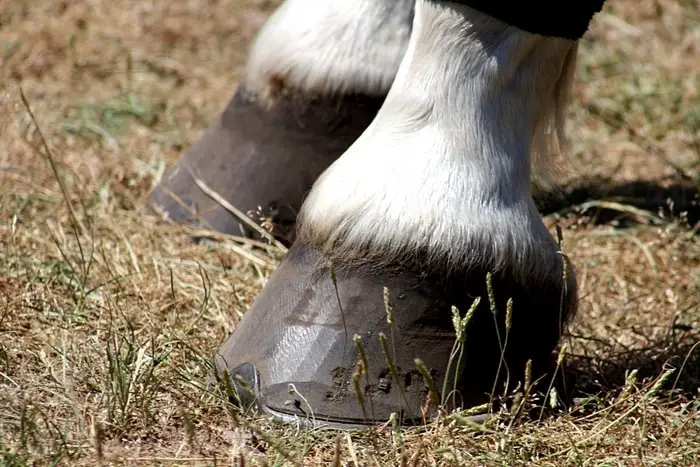
Causes of Founder in Horses
The common causes of founders are:
- Excess feeding of soluble carbohydrates.
- Attaining a body weight that is in keeping with what the feet can hold up is possible by reducing the feed intake for months.
- This often means a diet of no grain and delimited grass hay or limited amounts of low nutrient hay.
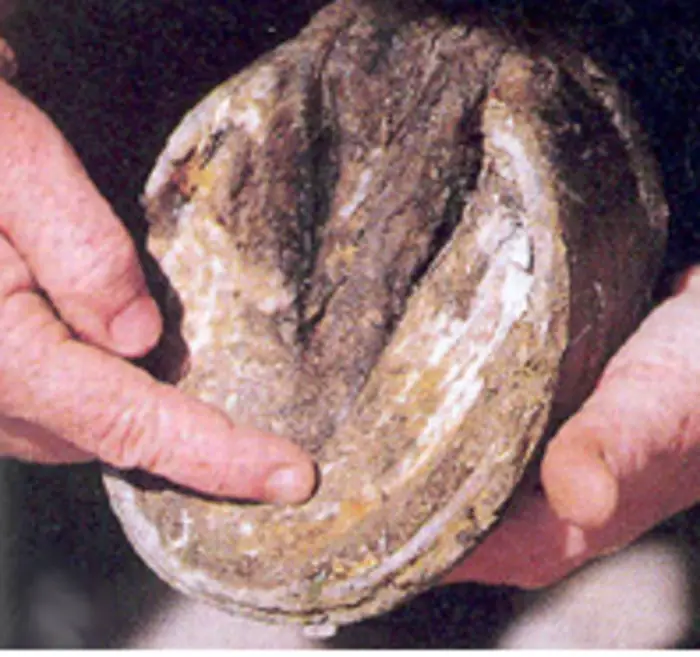
- The excess feed given either by mistake or by neglect over many months causes a large percentage of founder cases.
- A sudden significant increase in grain intake can also cause a founder.
- Retained placenta.
- Severe colic.
- Equine metabolic syndrome (EMS).
- Reaction to the ceratin antibiotic.
- Use of walnut shaving as bedding
Breeds Affected By Horse Founders
For not well-understood reasons, certain breeds and types of horse founder are more often than others. Some breeds have comparatively fewer founders than others. Fat ponies and miniature fat horses that are easy keepers are notorious for being targets of founders.
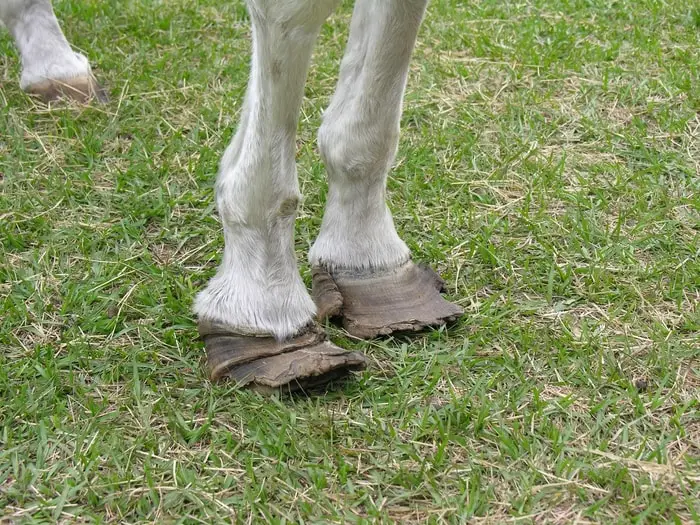
Clinical Signs of Founder in Horses
There are three types of founders; acute, chronic, and support-limb founder.
- The acutely founded horse is suffering from inflammation of the sensitive laminae of its feet. The sensitive laminae are a leaflike structure lined up vertically around the region between the hoof wall and coffin bone. There are approximately 600 laminae on each hoof, and secondary and tertiary laminae branch off from the 600 primary laminae. In most cases, only the front feet are affected by the founder; however, all four feet may be affected.
- Acute inflammation of the sensitive laminae beneath the hoof wall results from an incompletely understood biological phenomenon in which the sensitive laminae become detached from the insensitive laminae.
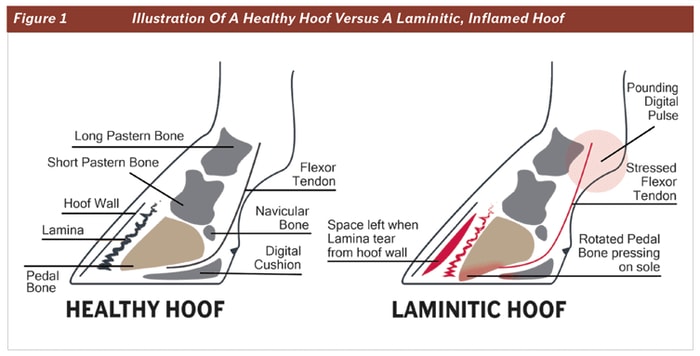
- The insensitive laminae make up the inner part of the hoof wall. They interlocked with the sensitive laminae and are attached to the coffin bone. This interlocking maintains the suspended nature of the coffin bone within the hoof.
- When a horse places its food on firm ground, especially when wearing shoes, the hoof wall becomes most transferred to the laminae and then to the skeletal support, starting with the coffin bone and progressing up the limb.
- The bones are kept aligned, and the force is cushioned by the various ligaments and is attached muscles, all of which are elastic in varying degrees.
- The laminae suspend a large portion of the weight of the horse. It is essential to bear n mind that the laminae are biologically alive and are taking part in the continual hoof growth process, which starts as the hairline.
- The degree of the founder in horses ranges from very mild to severe, resulting in continual pain.
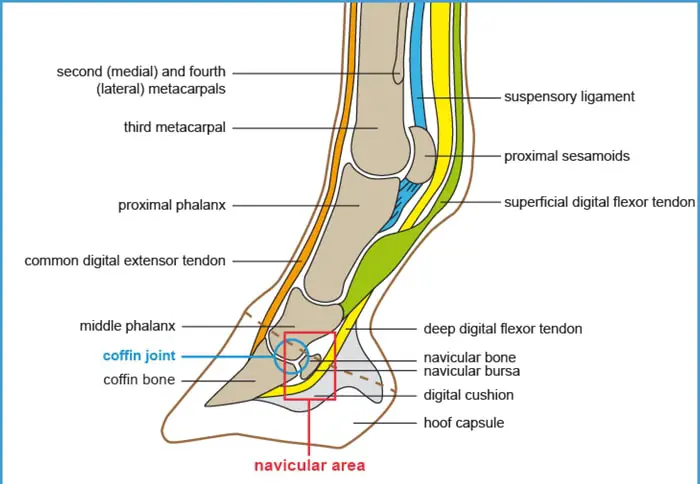
- The normal position of the bones in the foot is healthy. If the founder is severe, the coffin bone may drop away from its normal position within the hoof.
- The most significant drop or rotation, as it is usually called, occurs at the toe. This causes the windered “white line” and may cause the ‘seedy toe” associated with the founder.
- If the coffin bone rotates, the sole has fallen out also. The sole may even become convex, or the tip of the coffin bone may actually protrude through the sole, and then the sensitive tissue is exposed to bacterial infection.
- At the other extreme is the mild “touch” of the founder in horses, in which inflammation is evident but no rotation of the coffin bone occurs.
- Because of the pain within the laminar area, the horse tries to avoid weight-bearing and concussion as much as possible and thus places its heel to the ground first in a careful, deliberate heel-to-toe movement.
- When the initial inflammation subsides, which happens anywhere from one day to many weeks after the acute founder occurs, the horse is said to be either cured or have chronic founder in horses.
- In all cases of the chronic founder, there are abnormal growth rings on the hoof. The sole is flattened and thinner than average, and the front of the hoof wall may have a “dished” concave shape.
- The distance between the growth rings at the toe is less than the distance between the same growth rings at the quarter or heel. The result is that the toes curl upward if they are not trimmed regularly.
- The chronically founded horses may not show pain but usually move in a heel-to-toe step unless they are correctively shod or trimmed. Rotation of the coffin bone does not change the horse’s natural inclination to land flat on the coffin bone.
- The detection resulting from the ruptured lamina fills in with scar tissue and always leaves some permanent damage and weakened laminar attachment.
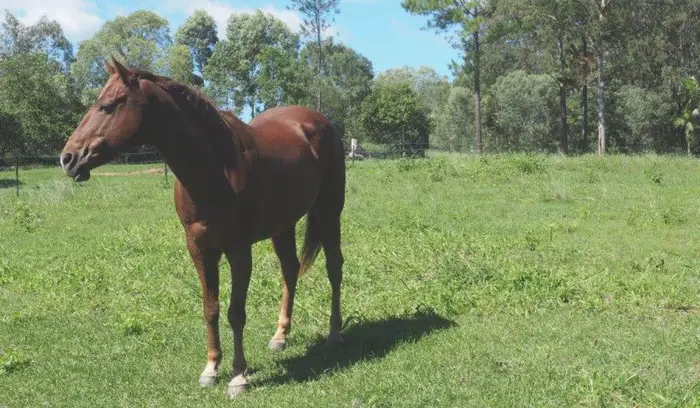
Management of Laminitis in Horses
- Use common sense about riding practices and training practices.
- Whenever possible, avoid speed on hard surfaces, let animals cool off after exercising them, and continue a parasite control.
- Preventive vaccination program recommended by the veterinarian.
- Do not overfeed your horse.
- Reduce the horse stress due to traveling.
- Never let your horse free access to grains.
- Administration of NSAID to reduce the pain.
- Administration of broad-spectrum antibiotics.
- Application of bandage at the affected foot.
- Cold therapy.
- Surgically incision of the digital flexor tendon.